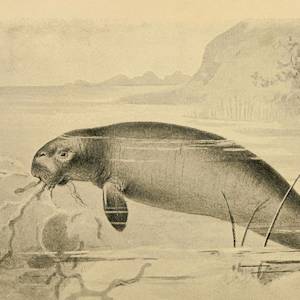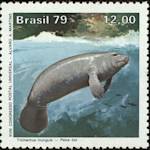Narwhal, "Unicorn of the sea"
2023 CE • Arctic Ocean
"The narwhal is the unicorn of the sea, a pale-colored porpoise found in Arctic coastal waters and rivers . . . These legendary animals have two teeth. In males, the more prominent tooth grows into a swordlike, spiral tusk up to 10 feet long. The ivory tusk tooth grows right through the narwhal's upper lip. Scientists are not certain of the tusk's purpose, but some believe it is prominent in mating rituals, perhaps used to impress females or to battle rival suitors . . . Like some other porpoises, they travel in groups and feed on fish, shrimp, squid, and other aquatic fare . . . Inuit people hunt the narwhal for their long tusks and their skin, an important source of vitamin C in the traditional Arctic diet." Although hunting is now strictly regulated, the cumulative impact of past exploitation and ongoing threats has contributed to a gradual decline in narwhal numbers over the years. The narwhal faces threats from noise pollution by ships, disrupting their navigation and ability to find food, as well as climate change-induced melting sea ice that affects their habitat and feeding patterns.
Quote: "Narwhal," National Geographic.
"Narwhal," Oceana.
Image: Biodiversity Heritage Library via Flickr, Public domain


Learn about Maya Lin’s fifth and final memorial: a multi-platform science based artwork that presents an ecological history of our world - past, present, and future.

Discover ecological histories and stories of former abundance, loss, and recovery on the map of memory.

Learn how we can reduce our emissions and protect and restore species and habitats – around the world.

See how art can help us rethink the problems we face, and give us hope that each one of us can make a difference.

Help make a global memorial something personal and close to home. Share your stories of the natural world.


